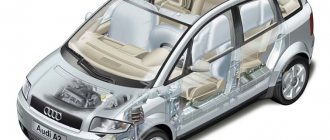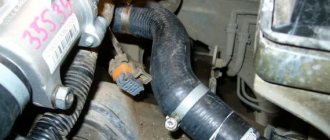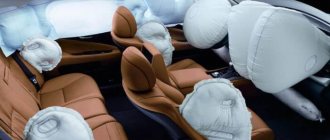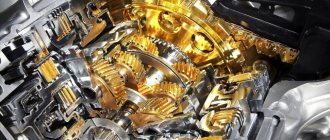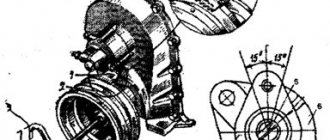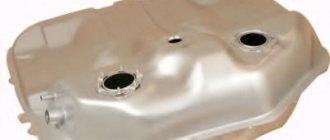ASR operating principle:
— The sensor informs about changes in the control unit, which in turn processes the received signal. — The control unit compares the wheel speeds and then transmits the command to the actuator. — The mechanism reduces the rotation speed of the wheel that is slipping and coordinates it with the performance of other wheels. Result:
The differential is not locked; as a result, when the car moves along an indirect trajectory, the wheels of the drive axle rotate in the normal mode, but at the same time have different speeds.
How does ASR work?
The drive wheels are influenced in two ways:
When the car moves at a speed of, say, 60 km/h (each brand has its own indicator), the wheel that is slipping is slowed down by the brake system. Why does this happen? The brake fluid pump, which is part of the ASR, creates the necessary pressure, the solenoids actuate the valves, which supply fluid to the brake cylinders. If the set speed limit is exceeded, the traction control control unit signals this to the engine, which in turn reduces the torque. If the car is equipped with an automatic transmission, then overdrive is activated, which leads to a “weakening” of the car’s traction characteristics.
Is it possible to disable ASR?
If necessary, you can deactivate the system. Typically, this option is useful for beginners who want to practice their driving skills on an empty road.
ASR OFF button
, which allows you to disable the option, in most cars is located near the gearshift lever or on the dashboard. When you press a key, the corresponding light will light up.
Detailed instructions for deactivating the system in your car are presented in the car's operating manual.
"Doubles" of the system
Cars of different brands are equipped with similar systems that have different names. Yes, A.S.R.
- This is the prerogative of cars from the German brands
Mercedes , Audi
and
Volkswagen
.
DSA
Opel cars .
TCS
Toyota
vehicles .
ASR, like other twin systems, is part of the stability control system known as ESP
.
Systems in a car - what do we differentiate?
Automotive safety systems are one of the fastest growing sectors of the automotive industry. From year to year, manufacturers do everything to make their cars as comfortable and safe as possible for users. It's not just about well-designed seats and soft upholstery, but above all about maximum protection for the driver, passengers and other road users. This is done by at least several modern systems and systems in the car - ABS, ESP, ASR . How do they work and why choose cars with them?
What is ESP in a car?
Electronic
Stability Program ,
or
ESP
, is an electronic stability control system, also called stability control. The main purpose of ESP is to control the torque of the wheels, which allows you to eliminate lateral movement and level the position of the car.
Like ASR, the system has several analogs that are used in specific brands of cars:
- ESC
is installed on KIA, Hyundai and Honda cars . - Rover, BMW and Jaguar are equipped with DSC
. - A distinctive feature of Volvo is the DTSC
. - VSA
in Acura cars . - Toyota models are equipped with VSC
. - Subaru, Nissan and Infiniti cars use the VDC
.
What does ESP consist of?
The system includes a control unit, measuring instruments that monitor various parameters, and a hydraulic unit.
ABS anti-lock braking system
.
— Anti-slip system ASR.
— EBD brake force distribution system
.
— Electronic differential locking system
EDS
.
How does ESP work?
External sensors analyze various parameters - the functioning of the braking system, the characteristics of the vehicle's movement, the position of the accelerator, and changes in the steering angle. This data is transmitted to the control unit. He compares the information received with the actual movement of the car. If ESP decides that the driver has lost control of the car, it intervenes in the control, that is, it uses mechanisms that are associated with other active safety systems.
Correcting the trajectory of the machine is carried out in several ways:
- By braking specific wheels. The system itself decides which wheels will brake. So, when skidding, braking is carried out by the outer front wheel.
- Thanks to changes in engine speed.
The ESP control unit also interacts with the engine and automatic gearbox of the car. This allows the system to adjust their operation in force majeure circumstances.
Parktronic
The system represents a group of devices responsible for assisting in driving a car when performing standard maneuvers. In this case we are talking about a parking assistant, some elements of which, however, can be used in other situations. So, parking sensors are the active safety of a car, which, through sensors and video cameras, allows you to park carefully and without the risk of a collision. Sensitive elements (sensors) are installed in the bumper area, which send light or sound signals to the interior in the event of a dangerous approach. Video cameras are a kind of optional addition that allows the driver to focus not only on signals, but also to observe what is happening in the parking area through a monitor connected to the rear or front camera.
What does ABS consist of and what is its operating principle?
The design of the system implies the presence of a control unit, speed control sensors and a hydraulic modulator.
The functioning of the anti-lock braking system involves three stages: releasing pressure in the brake system cylinder, maintaining it and increasing it to the required level. In reality it looks like this:
- When braking, speed sensors transmit data to the control unit.
- The control unit smoothly reduces the speed of the car.
If one of the wheels begins to slip or has completely stopped, the sensor informs the control unit about this, which activates the exhaust valve. It blocks fluid from entering the wheel brake cylinder - the pump immediately begins returning it to the hydraulic accumulator. The result is that the blocking is removed. When the wheel speed has returned to normal, the control unit closes the exhaust valve and opens the intake valve. As a result, the pump starts working again, but now it performs the actions “in the reverse order”: it pumps pressure into the brake cylinder, which allows the wheel to be braked. All these operations are carried out very quickly. They are repeated until the vehicle comes to a complete stop.
What are preventative security systems?
On many modern cars, some of the listed active and assistive systems are combined into large-scale technical systems of the so-called intelligent preventive safety using special software.
Their task is to prevent a collision, pre-prepare the braking system for braking, prepare for the activation of some passive safety systems, and also automatically change the speed of movement until a complete stop. Such electronic assistants include Collision Warning with Brake Support from Ford, Collision Warning with Auto Brake and City Safety from Volvo, Front Assist from Volkswagen, etc.
What does this give?
During emergency braking, cars equipped with ABS slow down smoothly rather than skidding. Consequently, even in difficult road conditions the car remains controllable. The driver only needs to monitor the direction of movement of the car until it comes to a complete stop. In other words, the anti-lock braking system provides controlled braking, which helps avoid an accident.
When emergency braking a vehicle not equipped with ABS, pressing the brake pedal hard means that no matter how much you twist the steering wheel, the car will not change its trajectory. This is because locked wheels will slip and prevent the driver from maneuvering. As a result, the car will drive in a straight line, which can lead to serious consequences.
Passive safety elements
When the driver is no longer able to independently prevent an emergency, elements of the vehicle’s passive safety system come into play.
The system includes the following components:
- Seat belts.
Seat belts
The idea to create a mechanism for tying the driver to the seat appeared in 1907, and already in 1959 the first car belts were produced. To this day, they remain the cheapest and most effective safety element. With the development of production technology and technology in general, belts with an automatic tension system began to appear, which work well together with airbags in the event of an emergency: they work immediately and press the person into the seat.
Depending on the type, model and configuration of the car, seat belts save lives in 50-55% of cases.
- Airbags.
Airbags
The pillow is an unremarkable bag made of synthetic material, the main task of which is to absorb the load as a result of a collision with the human body. Nowadays, pillows leave virtually no damage on the human body, however, previously they led to bruises on the body, and in extreme cases could cause deafness. Very often this happened to short people and children.
When using an airbag, you will save your life in three cases out of ten, and with the combined use of an airbag and a seat belt, the probability of a positive outcome increases to 80%.
- Seat headrests.
Seat headrests
The designers claim that head restraints also protect our body, in particular the neck, from serious injury when contacting the car body in the event of an emergency. However, according to the majority of people, the effectiveness of head restraints is exaggerated, and protection is achieved only under certain conditions.
- Structural integrity of the frame. A strong frame is the key to the safety of the driver and passengers during an accident.
- Firmly secured seat. Allows you to restrain the driver in the event of an accident and prevent him from moving around the cabin.
- Bumpers. Designed to absorb energy received at the moment of impact.
- Safe pedal assembly. Allows you to avoid damage to the driver’s legs, since a mechanism is implemented to separate the pedal from the mounting points during a collision.
- Glass production technology based on triplex, which does not cause much harm when broken.
- A mechanism for moving the engine and other elements of the car to the lower part during an accident to prevent them from entering the cabin and causing damage to passengers.
Passive safety is also influenced by the size of the body, the larger the safer, and the color.
Nuances worth knowing about
The effectiveness of the anti-lock braking system depends on the condition of the road. If you are driving on an uneven road surface with bumps and potholes, then the car’s braking distance will be much longer than usual. This is explained very simply. When a car slows down, its wheels “bounce” for a moment. This leads to loss of traction and, as a result, the cessation of rotation. ABS perceives this as a blockage and stops braking. When adhesion to the coating is restored, the system has to rebuild. This takes time - hence the increase in braking distance. To make the ABS work optimally in this situation, simply reducing the speed of the car will help.
It should be remembered that active safety systems help the driver in a difficult situation, and do not take control of the car, so the car enthusiast should not relax - he must be prepared for anything.
Sign up for service Service center contacts Ask a question
Passive safety is tested on dolls
Everyone knows that for crash tests, i.e. When testing a car for passive safety, dummies are used. But not everyone knows that such a seemingly simple and logical decision was not reached immediately.
At the beginning, human corpses and animals were used for testing, and in less dangerous tests, living people—volunteers—participated.
The Americans were pioneers in the fight for human safety in the car. It was in the USA that the first mannequin was made back in 1949. In its “kinematics,” it looked more like a large doll: its limbs moved completely differently from those of a human, and its body was solid. It wasn't until 1971 that GM created a more or less "humanoid" dummy. And modern “dolls” differ from their ancestor, much like a person from a monkey.
Now mannequins are made in entire families:
- two versions of the “father” of different height and weight,
- lighter and more miniature “wife”,
- a whole set of “children” - from one and a half years to ten years of age.
The weight and proportions of the body completely imitate the human condition. The metal “cartilage” and “vertebrae” work like the human spine. Flexible plates replace ribs, hinges replace joints, even the feet are movable. On top of this “skeleton” is covered with a vinyl covering, the elasticity of which corresponds to the elasticity of human skin.
Inside, the mannequin is stuffed from head to toe with sensors, which during testing transmit data to a memory unit located in the “chest.”
As a result, the cost of the mannequin is - hold on to the chair - over 200 thousand dollars. That is, several times more expensive than the vast majority of tested cars!
But such “dolls” are universal. Unlike their predecessors, they are suitable for passive safety tests:
- frontal,
- lateral,
- collision from behind.
Preparing the dummy for testing requires fine tuning of the electronics and can take several weeks. In addition, immediately before the test, paint marks are applied to various areas of the “body” to determine which parts of the interior are in contact during an accident.
We live in a computer world, and therefore passive safety specialists actively use virtual simulation in their work. This allows you to collect much more data and, in addition, such dummies are practically eternal.
Toyota programmers, for example, have developed more than a dozen models that simulate people of all ages and anthropometric data. And Volvo even created a digital pregnant woman.
World Day of Remembrance for Road Traffic Victims
Every year, around the world, about 1.2 million people die in road accidents, and half a million are injured or disabled.
In an effort to draw attention to these tragic figures, the UN declared every third Sunday in November as World Day of Remembrance for Road Victims in 2005.
Carrying out crash tests can improve the safety of cars and thereby reduce the above sad statistics.
We should not forget that there are a large number of used cars on the roads that do not always meet passive safety requirements.
Website editors
Publications on the topics: how to get a car loan, which car to choose for credit, conditions for car loans in banks for new and used cars, how to repay a car loan ahead of schedule, CASCO and MTPL insurance for a loan car. The editors of the “Car on Credit” website help you understand the issues of obtaining, repaying and servicing a car loan
Was this publication useful to you?
Bookmark it on social networks!
Total score: 3Votes: 1
How to get a Nissan loan - choosing Nissan X-Trail through the Nissan Finance program
Car warranty – car repair under warranty, maintenance of a warranty car
We recommend other useful posts on this topic:
Volkswagen Beetle - a classic people's car
German used cars - how to buy cars from Germany
Choosing a used car - tips for choosing a used car
Which new SUV to choose on credit so as not to regret the purchase
What new traffic police fines await drivers from September 1, 2013
9 Tips for Used Car Buyers - Inspecting a Used Car
